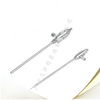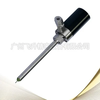Vacuum Valves
(164 companies)
Vacuum valves are used when a vacuum must be maintained in a closed system.
Diaphragm Valves
(407 companies)
Diaphragm valves close by means of a flexible diaphragm attached to a compressor.
Solids Valves
(178 companies)
Solids valves are used to control or regulate the flow of powder, granular and other bulk solid materials along a process line, or to and from process units, storage bins, conveyors and product packaging.
Plug Valves
(453 companies)
Quarter-turn plug valves use a cylindrical or tapered plug with a hole in the center to control straight through flow when in the open position.
Diverter Valves
(253 companies)
Diverter valves direct flow from one inlet to one of two or more outlets.
Mixing Valves
(181 companies)
Mixing valves combine the flow of two or more inlets into a single outlet for applications such as temperature and concentration control.
Pinch Valves
(168 companies)
Pinch valves include any valve with a flexible elastomer body that can be pinched closed, cutting off flow, using a mechanism or fluid pressure.
Spray Valves
(44 companies)
Spray valves are precision dispensing valves designed to provide precise fluid dispensation depending on applications. The dispensed output can flat or round. Dispensed product is sprayed onto target area, rather than placed directly on it.
Compressor Valves
(20 companies)
Compressor valves are valves used within a compressor to allow gas flow to and from the cylinder area.
Valve Positioners
(191 companies)
Valve positioners compare a control signal to a valve actuator 's position and move the actuator accordingly. They are used with both linear valves and rotary valves.
Solenoid Valve Connectors
(27 companies)
Solenoid valve connectors are used to connect solenoid valves and pressure switches.
Electrohydraulic Valve Actuators and Hydraulic Valve Actuators
(131 companies)
Electrohydraulic valve actuators and hydraulic valve actuators convert fluid pressure supply pressure into motion.
Pneumatic Valve Actuators
(429 companies)
Pneumatic valve actuators adjust valve position by converting air pressure into linear or rotary motion.
Dispensing Valve Systems
(149 companies)
Dispensing valve systems are designed to provide precise fluid dispensing depending on applications. The dispensed output can be a bead, dot, flat spray, round spray, or fill (potting). The type of dispensing pattern from dispensing valve systems is determined by valve design and is dependent on dispensed fluid properties.
Precision Dispensing Needle Valves
(53 companies)
Precision dispensing needle valves are designed to provide precise fluid dispensing depending on applications. The dispensed output can be in the form of a bead, dot or fill. The valve dispenses fluid when the activator (for example, air) acts on a piston, which shifts the spool or needle into the open position.

